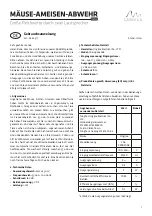
RP0193-2001
2
NACE International
Oxidation:
(1) Loss of electrons by a constituent of a
chemical reaction. (2) Corrosion of a metal that is exposed
to an oxidizing gas at elevated temperatures.
Piping: For the purposes of this standard, this term refers
to all piping associated with the transfer of products in and
out of storage tanks.
Reduction: Gain of electrons by a constituent of a chemical
reaction.
Reference Electrode: An electrode whose open-circuit
potential
is
constant
under
similar
conditions
of
measurement, which is used for measuring the relative
potentials of other electrodes.
Stray-Current Corrosion: Corrosion resulting from current
through paths other than the intended circuit, e.g., by any
extraneous current in the earth.
________________________________________________________________________
Section 3: Preliminary Evaluation and Determination of the Need for Cathodic Protection
3.1 This section outlines the information that should be
considered prior to designing a cathodic protection system
to protect on-grade carbon steel storage tank bottoms in
contact with an electrolyte.
3.2 Site Assessment Information
3.2.1 Prior to designing a cathodic protection system,
the following information should be obtained:
(a) Tank,
piping,
and
grounding
construction
drawings, including dimensions, etc.
(b) Site plan and layout
(c) Date of construction
(d) Material specifications and manufacturer
(e) Joint construction (i.e., welded, riveted, etc.)
(f)
Coating specifications
(g) Existing or proposed cathodic protection systems
in the area
(h) Location of electric power sources
(i)
Electrochemical properties of the tank bedding or
padding material
(j)
History of the tank foundation (i.e., whether the
tank has been jacked up/leveled, etc.)
(k) Unusual environmental conditions
(l)
Operating history of the tank, including leak
information (internal and external)
(m) Maintenance history of the tank
(n) Containment membranes/impervious linings
(o) Secondary bottoms
(p) Water table and site drainage information
(q) Liquid levels maintained in the tank
(r)
Nearby foreign structures
(s) Type of liquid stored
(t)
Operating temperature
(u) Electrical grounding
3.3 Predesign Site Appraisal
3.3.1 Determining the Extent of Corrosion on Existing
Systems
3.3.1.1 Information regarding the degree of
tank-bottom
corrosion
is
useful
because
considerable
bottom
damage
may
require
extensive repairs or replacement prior to the
installation of cathodic protection.
3.3.1.2 Field procedures for determining the
extent of existing corrosion may include:
(a) Visual inspection
(b) Tank bottom plate-thickness measurements
(ultrasonic testing, coupon analysis, etc.)
(c) Estimation
of
general
corrosion
rates
through the use of electrochemical procedures
(d) Determination
of
the
magnitude
and
direction of galvanic or stray current transferred
to or from the tank through piping and other
interconnections
(e) Determination
of
soil
characteristics
including
resistivity,
pH,
chloride
ion
concentration, sulfide ion concentration, and
moisture content
(f)
Estimation
of
the
degree
of
corrosion
deterioration based on comparison with data
from
similar
facilities
subjected
to
similar
conditions
3.3.1.3 Foundation
characteristics
are
also
important factors in the assessment of the extent
of existing corrosion.
The pad material of
construction, thickness of ringwalls, and water
drainage should all be considered.
3.3.1.4 Data pertaining to existing corrosion
conditions
should
be
obtained
in
sufficient
quantity
to
permit
reasonable
engineering
judgments.
Statistical procedures should be
used in the analysis, if appropriate.
Summary of Contents for CP 1
Page 1: ...CP 1 Cathodic Protection Tester Course Manual February 2005 NACE International 2000 ...
Page 265: ......
Page 266: ......
Page 267: ......
Page 268: ......
Page 301: ...RP0169 2002 32 NACE International ISBN 1 57590 035 1 ...
Page 535: ...TM0101 2001 24 NACE International ISBN 1 57590 137 4 ...
















































